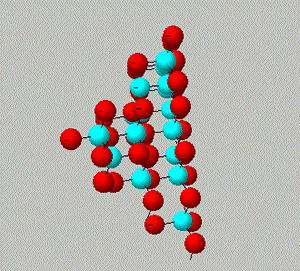Why is carbon the organic atom.
There are tow possibilities for an atom that gives life, silicon or carbon. Both reside in group 6 of the periodic table and have a valence of +4. Both can form tetrahedral arrangements such as CH4 or SiH4 .
But it is their differences that are really exciting.
Life is very complex and any atom that is used to produce organic molecules must have the ability to produce a phenomenal array of different types that are stable and long lasting. Some of these organic molecules will be responsible for keeping bones strong, retrieving long term memory, producing different psychological states , just to mention a few, but we get the picture.
So lets take a look at some differences between silicone based organic molecules and carbon based organic molecules .
The table on the right shows the strength of the C-C bonds over Si-Si bonds.
Si-Si bonds are also more reactive than C-C with acids, bases and are more likely to degrade in sunlight than C-C bonds.
-
| Property | Si-Si | C-C |
| Bond energy kJ/mol |
222 | 346 |
Bond length |
233 | 154 |
When it comes to building long chain molecules the alkanes come to mind as organic molecules. These molecules are put together by C-C bonds and alkyl groups, the simplest of which is CH3 . The C-H bond is extremely resistant to chemical breakdown as opposed to the Si-H bond which chemically reacts in a number of chemical environments. Since Si-Si bonds are weaker than C-C bonds, complex Si based molecules, such as proteins and carbohydrates and importantly nucleic acids, would be most unstable and subject to chemical breakdown.
Unlike carbon, silicone does not readily form silicone to silicone double or triple bonds nor does it form ring structures..
Consider the table on the right. It shows the bond energy of the hydrogen and oxygen bonds of silicone and carbon. It is clear that the Si-O and Si-H are significantly more stable than the Si-Si bonds and would therefore form in preference. This would exclude the formation of long chain polymers, such as proteins carbohydrates and nucleic acids. When you compare the bond energies of the C-C, C-H and C-O bonds you see they are not too dissimilar.
Since Si-O bonds are more stable than Si-Si bonds long chains of Si-O-Si-O would form in preference to Si-Si-Si chains. That would mean that chiral molecules such as enzymes and sugars could not form. Silicone based molecules are usually achiral and therefore limited to the array of organic compounds that can be produced from a limited number of atoms.
| Bond | Bond energy (kJ/mol) |
Bond length (pm = 10-12 m) |
| C-H | 411 | 109 |
| Si-H | 318 | 143 |
| C-O | 358 | 143 |
| Si-O | 452 | 163 |

1) On the right is an image of a silicone polymer backbone.
a) Discuss why molecules of such silicone polymers are achiral.
Solution
b) Why is it that polymers with a Si-O-Si-O backbone form as opposed to
Si-Si-Si-Si?
Solution
c) Why is it common for carbon based polymers to form C-C-C backbones.
Solution
3) Give one reason why S-Si bonds are generally weaker than C-C bonds
Solution